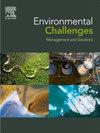在银行之外:为尼泊尔的环境流动铺平道路
Q2 Environmental Science
引用次数: 0
摘要
尼泊尔有巨大的水电潜力。虽然环境流(e-flows)的概念出现于21世纪初,但将其纳入水电开发仍处于早期阶段。这项研究首次全面评估了主要利益相关者对电子流量的认识,并确定了阻碍电子流量在尼泊尔水电部门被主流采用的主要挑战。此外,它还记录了利益相关者对水电开发对水生生物多样性和河流生态影响的看法。在2022年12月至2023年1月期间进行了一项广泛的调查,收集了来自不同利益相关者群体的反馈,包括政府机构、水资源开发商、用户群体、从业者、研究人员和学者。此外,在尼泊尔西部卡纳利河流域举行了焦点小组讨论。调查结果显示,只有50%的受访者熟悉电子流量的概念。然而,80%的人认为,该国现有的任何水电项目都没有充分实施电子流量。同样,72%的受访者认为水电开发导致生物多样性丧失,56%的受访者认为水电开发减少了下游水流。确定的主要挑战包括:(a)环境影响评估(EIA)后续工作不足,(b)监管执法不力,(c)公民社会监督不足,以确保环境影响评估建议得到遵守,(d)技术专长有限,以及(e)缺乏用户友好的电子流量估计方法。研究结果为政策制定者促进可持续水资源开发和减轻水电项目的生态影响提供了有价值的见解。本文章由计算机程序翻译,如有差异,请以英文原文为准。

Beyond the Banks: Paving the way for environmental flows in Nepal
Nepal has huge hydropower potential. Although the concept of environmental flows (e-flows) emerged in the early 2000s, its integration into hydropower development remains in the early stages. This study represents the first comprehensive effort to evaluate key stakeholders’ awareness of e-flows and identify the major challenges hindering their mainstream adoption in Nepal’s hydropower sector. Furthermore, it documents stakeholders’ perceptions regarding the impact of hydropower development on aquatic biodiversity and river ecology. An extensive survey was conducted between December 2022 and January 2023, collecting responses from a diverse group of stakeholders, including government agencies, water resource developers, user groups, practitioners, researchers, and academics. Additionally, focus group discussions were held in the Karnali River basin of western Nepal. The findings reveal that only 50 % of respondents are familiar with the e-flows concept. However, 80 % believe that e-flows have not been adequately implemented in any existing hydropower projects in the country. Similarly, 72 % of respondents perceive that hydropower development leads to biodiversity loss, while 56 % believe it reduces downstream water flow. The key challenges identified include (a) inadequate follow-up on environmental impact assessments (EIAs), (b) weak regulatory enforcement, (c) insufficient civil society oversight for ensuring compliance with EIA recommendations, (d) limited technical expertise, and (e) the absence of user-friendly e-flow estimation methods. The study's findings provide valuable insights for policymakers to promote sustainable water resources development and mitigate the ecological impacts of hydropower projects.
求助全文
通过发布文献求助,成功后即可免费获取论文全文。
去求助
来源期刊

Environmental Challenges
Environmental Science-Environmental Engineering
CiteScore
8.00
自引率
0.00%
发文量
249
审稿时长
8 weeks
 求助内容:
求助内容: 应助结果提醒方式:
应助结果提醒方式:


